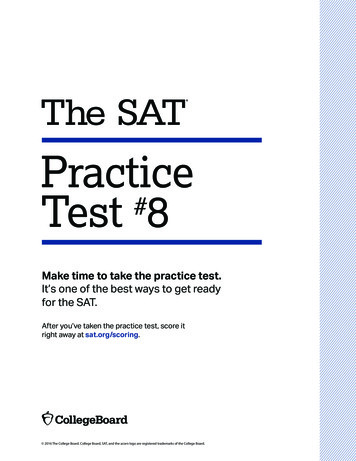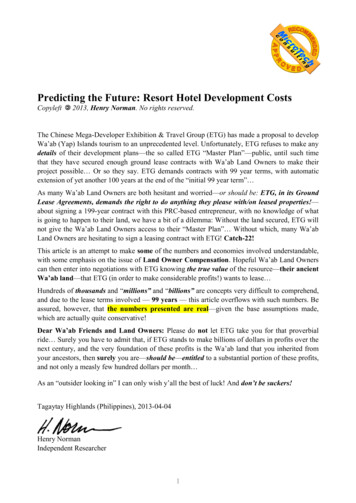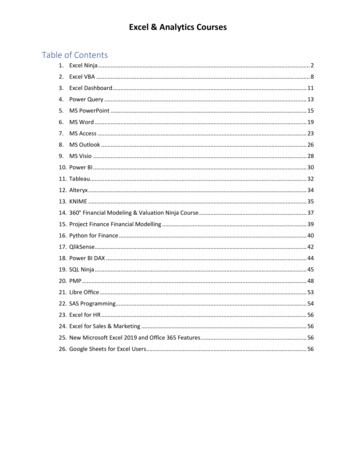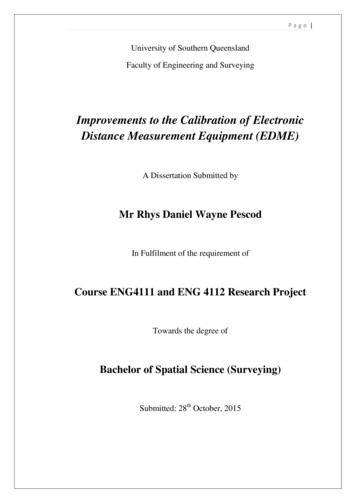
Transcription
B r i n g i n g L e g i s l a t o r s t o t h e Tab l eAddressing Hunger through Public-Private Partnerships
BRINGING LEGISLATORS TO THE TABLEAcknowledgementsThis publication was made possible through support and input from countless individuals and organizations.Thanks go to those who helped identify contacts, assisted in framing the project and reviewed and edited reportdrafts, particularly Ann Morse, Sheri Steisel and Jennifer Arguinzoni. Thanks also go to the members of the NCSLFoundation Hunger Partnership for their leadership and advice and to those who provided national perspective,including:17th Class of Bill Emerson National Hunger FellowsPhil Blalock, National Association of Farmers’ Market NutritionProgramsRev. Doug Greenaway and Samantha Lee, National WICAssociationMegan Lott, National Farm to School NetworkNed Porter and Maggie Reynolds, Wholesome WaveYvonne Siu, Corporate Voices for Working FamiliesCourtney Smith, Share Our StrengthEllen Vollinger, Food Research and Action CenterSpecial thanks go to those at state and local organizations who work tirelessly to serve and advocate on behalf ofpeople who experience hunger in their communities and who shared their insights for this publication, including:Erika Argersinger, Children’s Alliance of New HampshireKia Baker, Inter-Faith Food ShuttleCarol Barker, Auburn School DistrictJessica Bartholow, Western Center on Law and PovertyPatti Baum, Healthy New Hampshire FoundationKristen Coats and Marla Ianello, Upper Valley HEALTeresa Cook, Ohio District 5 Area Agency on AgingLisa Corbett, Three Square Food BankDawn Crayco, End Hunger Connecticut!Frank Diggs, Connecticut Department of Social ServicesAllison Goodman, City Schools of DecaturAngel Gutierrez, Catholic CharitiesCindy Hallman and Sharon Pierson, Desert Mission Food BankJoyce Hardy, Arkansas Hunger Relief AllianceSenator Steven Horsford and Polly Bates, Culinary Academy of LasVegasMichael Iceland and Ki Kim, The Food ProjectJon Janowski, Hunger Taskforce of WisconsinCheryl Jones-McLeod, Maryland Hunger SolutionsKevin Keegan and Kaleisha Biggs, Family League of BaltimoreAlison Keller, United Way of Central and Northeastern ConnecticutDr. Phil Kenkel, Oklahoma State UniversityMike Koch, New Britain Public SchoolsRick McNary, Numana, Inc.Grace Mekelski, Vermont Department of HealthMario Obledo, Jr., San Antonio Food BankJennifer Owens, Georgia OrganicsCarrette Perkins, New York City Coalition Against HungerNancy Pope, New Mexico Collaboration to End HungerDana Pritchet, North Dakota Department of AgricultureDr. David Procter, Kansas State UniversityBrianna Almaguer Sandoval, The Food TrustAndrew Schiff, Rhode Island Community Food BankCommissioner Scott Soares, Massachusetts Department ofAgricultural ResourcesKathy Underhill and Katherine Moos, Hunger Free ColoradoBob Waldrop and Chelsey Simpson, Oklahoma Food CooperativeDon Wambles, Alabama Farmers’ Market AuthorityAbout the AuthorMarie Lawrence is a 2010-2011 Bill Emerson National Hunger Fellow placed with the NCSL Hunger Partnership.The Emerson National Hunger Fellowship is a program of the Congressional Hunger Center in Washington, D.C.,that seeks to fight hunger by developing leaders. Marie has worked on a range of food and nutrition issues,including increasing access to healthy food in low-income neighborhoods, improving food stamp outreach tovulnerable populations and implementing municipal food policy. Marie received her B.A. in Public Policy Studiesfrom Duke University.National Conference of State LegislaturesWilliam T. Pound, Executive Director7700 East First PlaceDenver, Colorado 80230(303) 364-7700444 North Capitol Street, N.W., Suite 515Washington, D.C. 20001(202) 624-5400www.ncsl.orgISBN 978-1-58024-540-8 2011 by the National Conference of State LegislaturesAll rights reserved.
MEMBERSHIPLegislatorsSenator Renee Unterman, Co-Chair, GeorgiaSenator Steven Horsford, Co-Chair, NevadaRepresentative Martha Alexander, North CarolinaSenator Betty Boyd, ColoradoSenator Mike Brubaker, PennsylvaniaSenator Rich Crandall, ArizonaSenator Joni Cutler, South DakotaRepresentative Dwight Evans, PennsylvaniaAssemblymember Felipe Fuentes, CaliforniaSenator Judy Lee, North DakotaSenator Steve Morris, KansasRepresentative Eric Pettigrew, WashingtonSenator Juan Pichardo, Rhode IslandSenator Leticia Van de Putte, TexasRepresentative Mary Jane Wallner, New HampshireLegislative StaffGail Gronert, Special Assistant to the Speaker, CaliforniaCharles Sallee, Deputy Director, Legislative Finance Committee, New MexicoAnne Sappenfield, Senior Staff Attorney, Legislative Counsel, WisconsinElaine Zimmerman, Executive Director, Commission on Children, ConnecticutPartnersElaine Ryan and Erika Stratmann, AARPSteve Lodge, David Thorp and Jim McGreevy, American Beverage AssociationMike Zumwinkle, Ann Knapke and Jenny Engh, CargillElizabeth Tansing, Food Marketing InstituteLee Anderson and Ellen Luger, General MillsMatt Hedberg and Alex Franco, Mead Johnson NutritionMolly Fogarty, Rolly Prager and Brian Flaherty, Nestlé USAGray McGinnis, Ryan Irsik and Laura Smalling, Wal-MartPaul Carothers, Matt Lathrop and Kevin Lundy, Yum! BrandsAdvisory PartnersEd Cooney and Margaret Zeigler, Congressional Hunger CenterDavid Lee, Feeding AmericaEllen Vollinger, Food Research and Action CenterNational Conference of State Legislatures Page 1
HUNGER PARTNERSHIP OVERVIEWOne in seven U.S. households was food insecure at some point in 2009. The prevalence of food insecurity is at itshighest level since 1995, when the first national food security survey was conducted. Despite record high rates offood insecurity, academics, advocates and policymakers insist that hunger is a solvable problem.The U.S. Department of Agriculture and state agencies administer 15 federal nutrition programs, which providevital benefits to low-income families and significant economic stimulus to local economies. For example, in federalfiscal year 2010, 40.3 million people participated in the Supplemental Nutrition Assistance Program (SNAP). TheUSDA estimates that, for every 5 in individual benefits, at least 9 is generated in the local economy.In the last year, the private and non-profit sectors have committed significant resources to address hunger inAmerica, leveraging federal programs and enlisting their employees, customers and clients to improve theavailability and accessibility of affordable, healthy food for those who need assistance.State legislators play a significant role in addressing hunger in their roles of overseeing the administration of federalprograms, regulating and funding state programs, and convening otherwise disconnected partners to promoteeffective programs and encourage participation.The NCSL Foundation for State Legislatures launched this initiative to raise the visibility of hunger in America andhighlight innovative and lasting solutions. The goal of this initiative is to connect the public and private sectors toimprove the availability of healthy food for hungry families. The Hunger Partnership links legislators, legislativestaff and interested businesses to identify innovative and successful programs and develop bipartisan, balanced andconcise materials and mechanisms to support legislators in their efforts to reduce hunger in America.NCSL Foundation Hunger PartnershipNational Conference of State Legislatures444 North Capitol Street, N.W., Suite 515Washington, D.C. 20001(202) 624-5400http://www.ncsl.org/hungerNCSL Staff: Ann Morse, Sheri Steisel, Jennifer Arguinzoni andCaroline CarlsonContentsOverview Executive Summary . Site Visit Spotlight: Boston, Mass. . . I. SNAP Partnerships .II. Child Nutrition Partnerships .III. Food Distribution Partnerships IV. Healthy Food Access Partnerships Site Visit Spotlight: San Antonio, Tex. .Highlighting Hunger as Community Leaders .Glossary of Terms . . Index of Programs .National Conference of State Legislatures Page 2234510172125262729
EXECUTIVE SUMMARY“It doesn’t matter if you’re aDemocrat or a Republican. Everyonecan get on board and do something.”Senator Renee UntermanState legislators are in a unique position to tackle hunger and increase access toCo-Chair, NCSL Foundationhealthy food. Legislators simultaneously wear the hats of policymaker, hungerHunger Partnershipchampion and community leader. As policymakers, legislators can direct andprovide incentives for state agencies to implement new programs, catalyzecoordination among agencies, give start-up or expansion funding to promising initiatives and establish an award torecognize an organization fighting hunger in their communities. As hunger champions, they can form legislativehunger caucuses, create days for hunger awareness and elevate the visibility of hunger through their websites andsocial media. As community leaders, they can bring together the public, nonprofit, corporate and foundationsectors to inspire meaningful change and imagine innovative solutions for low-income communities. In short, statepolicymakers have the chance to serve as leaders in the battle to end hunger in the United States, starting with theircommunities and their states.Within this publication, Bringing Legislators to the Table: Addressing Hunger through Public-Private Partnerships, areexamples of innovative programs that involve partnerships among multiple organizations and state-level support.This publication has categorized programs broadly by their purpose and the federal nutrition programs they seek toleverage and promote. The thematic areas are:I.Supplemental Nutrition Assistance Program Partnerships, including programs that provideoutreach, offer application assistance and increase access to food retailers that accept SNAP;II. Child Nutrition Partnerships, including programs that increase access and improve the quality of inschool and out-of-school nutrition programs for children;III. Food Distribution Partnerships, including programs that improve the quality of food available atfood banks and pantries, increase client choice, and provide clients with the knowledge to choosehealthier and more cost-effective foods;IV. Healthy Food Access Partnerships, including programs that improve access to healthy food in urbanand rural low-income communities, increase access to locally grown produce for low-incomeconsumers and help improve the diets of low-income seniors.Each program profile includes information about the problem(s) the program seeks to address, how the programworks and who benefits, the names of major partners and funding sources, relevant legislation or legislatorinvolvement, and program results.The guide was researched and published by the NCSL Foundation Hunger Partnership. The author consultedseveral national organizations to identify states with promising programs and campaigns and, in turn, relied on statelevel administrators and non-profit staff to identify innovative programs. Leadership from state and localorganizations provided the information in the program profiles that follow. Although the author identifiednumerous innovative partnerships across the country, featured programs were selected using the following criteria: Involves both the private and public sectors, including state-level support, whether through provisionof funding, technical assistance or other resources; Demonstrates innovation in program delivery; Provides evidence of success and promise of self-sustainability; Involves a diverse array of organizations, including supermarkets, restaurants, farmers, child careproviders, schools, religious institutions, emergency food providers, health providers, private citizens,and additional community-based organizations; Benefits a wide variety of consumers, including children, youth, seniors, people with disabilities, andracially/ethnically diverse populations; Reflects diversity in rural and urban locales and various regions of the United States.The promising practices within this guide illustrate not only what is being done across the country, but howlegislators can play a vital part in leveraging resources and expertise to address the challenge of hunger in America.National Conference of State Legislatures Page 3Back to Contents
SITE VISIT SPOTLIGHTThe Food Project Boston, MassachusettsIn the StatehouseLegislators can direct or grant stateagencies authority to purchaselocally grown foods. In 2010, theMassachusetts legislature enactedHB 4919, requiring the state tomake reasonable efforts toprocure foods locally. The lawrequires the state to purchase localfoods unless the cost is more than10 percent greater than the cost forcomparable food produced outsidethe state. The law also requires theDepartment of Agriculture and theDepartment of Elementary andSecondary Education to collect datafrom food producers and schools tofacilitate increased local foodprocurement.ContactMargaret WilliamsExecutive DirectorThe Food Project(617) e Food Project (TFP) provides leadership development opportunities foryouth and adults from diverse backgrounds and works to increase access tohealthy food for residents of the greater Boston area. Each year, TFPinvolves teens and thousands of volunteers to farm nearly 40 acres in andaround Boston and increase the community’s capacity to grow its own food.TFP is funded by a large number of individual, community and localcorporate donors. Read more at http://www.thefoodproject.org.Youth Leadership DevelopmentTFP provides leadership development opportunities for youth in the greaterBoston area. Youth participate in summer programs, academic yearprograms and internships with TFP. The Summer Youth Program employsmore than 100 youth ages 14 to 17 in crews that work in the gardens, sellproduce at the farmers’ market, prepare and serve lunches at hunger relieforganizations and prepare community meals using fruits and vegetablesfrom the garden. Summer Youth Program participants are eligible to applyfor the Academic Year Program, which employs teens who work onSaturdays and during optional after-school hours. In addition to the tasksperformed by summer participants, academic year participants speak atconferences and external events about their work at TFP. Alumni of eitherprogram may apply to become interns, who complete project-based workand further develop job and public speaking skills. In 2010, TFP employed145 teens in its three leadership development programs.Build-a-GardenAlthough many low-income residents of Boston want to garden, they oftenlack the resources, expertise or appropriate space to do so. Soil studies showthat land in low-income neighborhoods contains dangerous levels of leadand is not safe for traditional gardening. TFP’s Build-a-Gardenprogram helps new and experienced gardeners build theinfrastructure and knowledge to grow food successfully andsafely near where they live. Interested community membersand community groups fill out an application, and TFPprovides accepted applicants with a raised bed garden orcontainer garden kit; seeds and transplants; a printed growingguide; workshops; and additional support by phone, e-mail,blog and newsletter. In 2010, TFP built 205 raised beds, anearly 100 percent increase over 2009.Farmers’ Markets and Community Supported AgricultureTFP sells a portion of its produce through five communitysupported agriculture projects and at five farmers’ markets inthe Boston area. TFP also provides staff and strategic supportto the Boston Bounty Bucks program, an incentive program that provides adollar-for-dollar match up to 10 for customers who buy produce atfarmers’ markets with SNAP or WIC.National Conference of State Legislatures Page 4Back to Contents
I. SNAP PARTNERSHIPS SNAP Outreach to Newly Eligible FamiliesArkansas Hunger Relief Alliance onThe Arkansas Hunger Relief Alliance (AHRA) is a network of food banksand food pantries throughout Arkansas. In 2009, the Alliance and itsmembers provided more than 25 million pounds of food to hungryArkansans.OpportunityA recent study by Feeding America found that just 28 percent of peoplewho receive emergency food in Arkansas participate in SNAP.Program DescriptionThe SNAP outreach initiative at AHRA, part of the Arkansas No KidHungry Campaign, provides SNAP outreach materials to likely eligiblefamilies and SNAP outreach resources to staff and volunteers at food banksand pantries. AHRA works with the state to develop and distribute thematerials and with staff and volunteers at local food banks and pantries toincrease SNAP participation statewide.As recently as 2010, the Arkansas Department of Human Services (DHS)distributed just one type of brochure to likely eligible SNAP clients; itfeatured photographs and messages targeting seniors. AHRA saw the needto also target families and newly eligible households. AHRA worked withDHS to produce and distribute a new SNAP brochure featuringphotographs of families and supportive messages. The brochureemphasizes that SNAP benefits are available for a families who “fall ontough times” and that spending SNAP dollars bolsters the local economy.AHRA also developed training materials to empower food bank and pantrystaff and volunteers to assist emergency food clients with SNAPapplications. AmeriCorps VISTA members working for AHRA train staffand volunteers to learn commonly reported barriers to SNAP participation,program myths and facts, and how to help clients complete online andpaper SNAP applications. The VISTAs are also developing a train-thetrainer program so food bank staff can conduct trainings for volunteers attheir partner food pantries.ResultsTo date, 47 foods banks and pantries across Arkansas have received SNAPoutreach training. SNAP enrollment has increased since the project’sinception, and state eligibility workers report seeing a large and increasingnumber of applications bearing the Share Our Strength stamp, which isimprinted on applications completed in food banks and pantries.AHRA also worked with DHS to create a question on the onlineapplication that links applications with AHRA’s outreach efforts. DHS willalso continue to credit paper applications with the Share Our Strengthstamp to AHRA’s initiative, with the first official data available in July 2011.Partners and FundingThe SNAP outreach initiative is apartnership between the ArkansasHunger Relief Alliance, theArkansas Department ofHuman Services, and AHRA’snetwork of food banks andpantries. Funding and in-kindresources are provided by Walmart , Share Our Strength,AmeriCorps VISTA andFeeding America. TheGovernor’s Office procuredcomputers for food pantries, andlocal Internet providers offerfree or discounted Internet topantries that do not have service.In the StatehouseState legislators can create or joinlegislative caucuses on hunger. The68-member Arkansas LegislativeHunger Caucus, which includesmembers from both parties, meetsregularly to discuss and advancehunger-related policies. Caucusmembers participate in eventshosted by AHRA, including servingas wait staff during their Serving UpSolutions dinner.State legislators can provide muchneeded funding to hunger relieforganizations. In 2011, the Arkansaslegislature enacted HB 1649,appropriating 2 million to theArkansas Hunger Relief Allianceand its membership network.ContactJoyce HardyNo Kid Hungry Campaign DirectorArkansas Hunger Relief Alliance(501) 399-9999. ext. 24jhardy@arhungeralliance.orgNational Conference of State Legislatures Page 5
Partners and FundingMaking Dinner a SNAP is apartnership between Ohio District5 Area Agency on Aging, fiveindependently ownedsupermarkets, the Richland CountyDepartment of Job and FamilyServices, and local senior centers.SNAP is administered by countyagencies, rather than a single stateagency. Funding for the project’sfirst 18 months was providedthrough one of 14 grants nationwidefor independent SNAP outreachprojects. Pending approval, ongoingfunding will be provided throughthe Ohio state USDA SNAPOutreach Plan. Volunteers for theproject are coordinated by AAA andlocal senior centers.ContactTeresa CookCommunity Programs ManagerDistrict 5 Area Agency on Aging(800) 522-5680, ext. 1120tcook@aaa5ohio.org Making Dinner a SNAPDistrict 5 Area Agency on Aging hio District 5 Area Agency on Aging Inc. (AAA) is a private nonprofit designated by the State of Ohio to be a Planning and ServiceArea as required in the federal Older Americans Act. AAA providesinformation and referrals, supportive and in-home services, andtraining for a service and resource network for seniors and peoplewith disabilities in AAA’s nine-county service area.OpportunitySeniors and people with disabilities, especially those living in rural areas, areconsistently under-enrolled in SNAP. AAA estimated 700 likely eligibleseniors were living in its service area.Program DescriptionStarted in 2010, AAA’s “Making Dinner a SNAP” works to increase SNAPparticipation among seniors in Richland County and conducts cookingdemonstrations to show seniors how to make healthy, low-cost meals. Theprogram is a partnership between AAA and five small grocers in RichlandCounty.AAA brings a portable, private screening booth equipped with a computerand Internet connection into supermarkets. Outreach volunteers trained byAAA help staff the booth by talking with clients about the benefits ofSNAP participation; assisting clients with the online pre-screening form;and, if they are eligible, helping clients complete a paper SNAP application.The applications are sent to staff at the local Department of Jobs andFamily Services who conduct eligibility interviews, gather verificationdocuments and disburse benefits.Cooking demonstrations are provided near the booth by a local volunteerchef. A local senior center provides food for the demonstrations. The chefdistributes healthy, low-cost recipes and talks with clients about how tostretch their SNAP dollars.AAA posts the screening booth schedule on its website and advertises theschedule in inserts in grocery bags, flyers, television ads, andannouncements in church and food pantry newsletters.AAA attributes the project’s success to its partnerships. Project staff saidgrocers were the natural partners because they were the “commondenominator” among seniors who were otherwise disconnected frombenefit programs and geographically isolated. Small, rural grocers knowtheir customers by name and help steer likely eligible seniors to the booth.In addition, the partnership with the senior center allows the cookingdemonstrations; they are not possible under the USDA grant, since food isnot an allowable outreach grant expenditure.ResultsTo date, AAA has helped more than 500 seniors pre-screen for SNAP atgrocery stores, 246 of whom received benefits as a result.National Conference of State Legislatures Page 6
DSS Rx-Xpress BusDepartment of Social Services w.asp?a 2514&q 316938OrganizationThe Connecticut Department of Social Services (DSS) provides services tothe elderly, people with disabilities, families and those who need help tomaintain or achieve their full potential for independent living. DSSadministers 90 legislatively authorized programs and one-third of the statebudget.OpportunitySeniors and people with disabilities face unique challenges in enrolling inpublic programs and often demonstrate particularly high need for suchbenefits. Lack of access is exacerbated by state budget cuts that causeeligibility offices in rural and less densely populated areas to close oroperate fewer hours per week with fewer staff members.Program DescriptionStarted in 2005, the Rx-Xpress is a mobile benefits screening, enrollmentand referral facility designed to reach seniors, people with disabilities andlow-income households in rural or underserved areas of Connecticut. DSSactively partners with other state agencies and various anti-hunger andhealth care-related non-profit organizations to conduct or augment plannedbenefits enrollment events.The bus is a self-contained facility that is accessible to the most vulnerablepopulations in the state. The bus is equipped with four computerworkstations, a printer/scanner/fax machine, a TV and DVD player, aninteractive whiteboard for trainings, a wall of brochures and a satellite thatprovides continuous Internet access even in remote areas of the state. Theworkstations provide privacy for clients while they talk with DSS staff. Buscomputers have the same software as permanent state offices, so bus staffcan make eligibility determinations on the spot. To maximize accessibility,the bus has a wheelchair lift and external and internal hand rails.The bus accepts requests to visit community events and organizations,including SNAP outreach events, emergency food distribution sites, seniorcenters, libraries, pharmacies, health centers, street fairs, churches andfarmers’ markets. The DSS bus comes to mobile pantry drops, for example,where emergency food from Food Share, a local food bank, is distributed inrural parts of the state. The bus is also used by state Medicaid staff to trainnew benefits counselors and community staff in rural areas. The bus’s stopsare posted in advance on the Connecticut Aging Services Division website.ResultsThe bus has provided services to almost all of the state’s 169 urban andrural towns. From November 2005 to October 2010, the bus providedservices at 459 events to 8,090 individuals who may not otherwise have hadaccess to a DSS office to enroll in SNAP. The bus helped facilitate 1,790SNAP applications. Staff estimate that one in 10 applicants is certified forbenefits on the spot.Partners and FundingSNAP outreach provided by theDSS Rx-Xpress is a partnershipbetween the state Department ofSocial Services, End HungerConnecticut!, the HispanicHealth Council and theConnecticut Association forHuman Services. Together, thepartners work to identify events forthe bus, and the bus helps meet theorganizations’ SNAP outreach goals.The bus is staffed by representativesfrom DSS and staff from other stateagencies and partner non-profitorganizations as needed. Start-upfunding for the project wasprovided by the StatePharmaceutical AssistanceProgram in preparation for thelaunch of Medicare Part D. Ongoingfunding is provided through generalDSS funds.In the StatehouseLegislators can adopt state policyoptions to increase access to federalnutrition programs. In 2009, theConnecticut legislature enacted SB843, increasing the income limitfor SNAP eligibility to 185percent of federal poverty andeliminating the asset test undercategorical eligibility.ContactFred DiggsBus CoordinatorConnecticut Department of SocialServices(860) 424-5245fred.diggs@ct.govNational Conference of State Legislatures Page 7
Partners and FundingThe Hunger Free Hotline is apartnership between Hunger FreeColorado, Kaiser Permanente andthe Colorado Department ofSocial Services. Funding providedby USDA SNAP Outreach ispassed through the state agency andis augmented by funding fromKaiser and private donations toHFC. The state agency manages thegrant without drawingadministrative funding from thegrant total before passing it to HFC.In the StatehouseLegislators can direct agencies toapply for federal funding. In 2010,the Colorado legislature enacted HB1022, directing the state agency toformulate a state SNAP OutreachPlan, establishing categoricaleligibility for SNAP applicants andeliminating the asset test requiredfor SNAP eligibility. The lawprovides for partnerships with nonprofit organizations andencourages—but does not require—the state to match federal fundingfor outreach.Legislators can create legislative taskforces to advance positive policyoptions for SNAP and otherprograms. In 2009, the Coloradolegislature enacted HB 1064,creating the EconomicOpportunity Poverty ReductionTask Force. The bicameral,bipartisan task force championed anumber of policies to increaseaccess to federal means-testedprograms for families strugglingduring the recession.ContactKathy UnderhillExecutive DirectorHunger Free Colorado(720) 328-1284kathy@hungerfreecolorado.org Hunger Free HotlineHunger Free Colorado ree-hotline.htmlOrganizationLaunched through a merger of organizations in 2009, Hunger FreeColorado (HFC) is a statewide anti-hunger organization that acts as theleading authority on the issue of hunger in the state. HFC works tostreamline federal and local benefits systems and advance innovativesolutions to Colorado’s hunger challenges through policy, coalitionbuilding, collaborative programming and targeted awareness building.OpportunityMany people who are currently eligible for but are not enrolled in SNAP inColorado have never navigated the public benefits system. At the sametime, county eligibility offices are overwhelmed with clients.Program DescriptionIn 2011, Hunger Free Colorado launched the Hunger Free Hotline to helpthose seeking assistance navigate the complex system of federal nutritionprograms. The hotline operates Monday through Friday from 8:00 a.m. to4:30 p.m. through a toll-free line with more than 1,000 referral resources.The hotline is staffed by three “resource navigators” and a hotlinesupervisor who are trained to make callers aware of federal assistanceprograms, conduct high-level eligibility pre-screenings, locate places toapply, and tell callers which documents to bring to interviews. Staff canassist callers in either English or Spanish. The purpose of the hotline is notto simply answer q
Joyce Hardy, Arkansas Hunger Relief Alliance Senator Steven Horsford and Polly Bates, Culinary Academy of Las Vegas Michael Iceland and Ki Kim, The Food Project Jon Janowski, Hunger Taskforce of Wisconsin Cheryl Jones-McLeod, Maryland Hunger Solutions Ke










